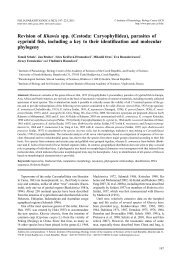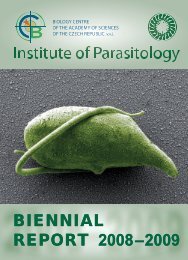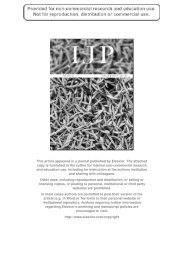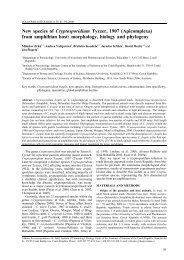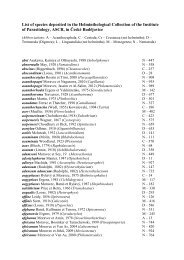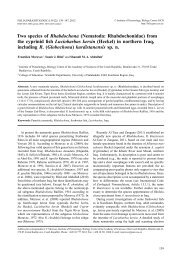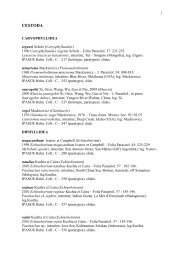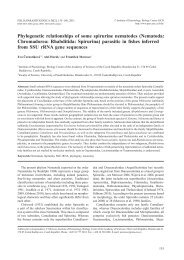Coccidia of rabbit: a review
Coccidia of rabbit: a review
Coccidia of rabbit: a review
Create successful ePaper yourself
Turn your PDF publications into a flip-book with our unique Google optimized e-Paper software.
Table 1. Localisation <strong>of</strong> <strong>rabbit</strong> intestinal coccidia in the host and number <strong>of</strong> their asexual generations.<br />
Species Intestinal segment<br />
Localisation in the mucosa<br />
No. asexual Reference<br />
(except E. stiedai)<br />
(except E. stiedai)<br />
generations<br />
E. coecicola appendix, sacculus rotundus, Peyer’s patches 1st AG in GALT; 2nd–4th AG<br />
and gamogony in epithelium<br />
<strong>of</strong> domes and mushrooms<br />
4 Pakandl et al. 1993, 1996a<br />
E. exigua duodenum–ileum; successively moves from tops <strong>of</strong> the villi<br />
proximal to distal parts <strong>of</strong> the small intestine<br />
4 Jelínková et al. 2008<br />
E. flavescens 1st AG small intestine, 2nd–5th AG caecum 1st AG in crypts; 2nd–4th<br />
5 Norton et al. 1979, Gre-<br />
AG in superficial epithelium;<br />
gory and Catchpole 1986,<br />
5th AG and gamonts in crypts<br />
Pakandl et al. 2003<br />
E. intestinalis lower jejunum and ileum 1st and 2nd AG in crypts;<br />
3rd and 4th AG and gamonts in<br />
crypts and wall <strong>of</strong> the villi<br />
3–4 Licois et al. 1992<br />
E. irresidua jejunum and ileum 1st AG in crypts; 2nd AG in lamina<br />
propria; 3rd AG, 4th AG and gametocytes<br />
in the villous epithelium<br />
4 Norton et al. 1979<br />
E. magna jejunum and ileum,<br />
intestinal villi (walls and tops)* 4 Ryley and Robinson 1976,<br />
in a lesser extent duodenum<br />
Pakandl et al. 1996b<br />
E. media duodenum–jejunum, low concentration<br />
<strong>of</strong> the parasite in the ileum<br />
intestinal villi (walls and tops) 3 Pakandl et al. 1996c<br />
E. perforans maximal parasite concentration in the duodenum,<br />
but also in the jejunum and ileum<br />
both villi and crypts 2 Streun et al. 1979<br />
E. piriformis colon crypts 4 Pakandl and Jelínková 2006<br />
E. vejdovskyi ileum 1st–3rd AG in crypts;<br />
4th and 5th AG in villi<br />
5 Pakandl and Coudert 1999<br />
E. stiedai liver epithelium <strong>of</strong> biliary ducts 5–6 Pellérdy and Dürr 1970<br />
AG – asexual generation; GALT – gut-associated lymphoid tissue; *according to Ryley and Robinson (1976), only the 1st AG is located in crypts,<br />
while Pakandl et al. (1996b) found only the 4th. AG in the crypts and other stages in the villous epithelium.<br />
Although life cycles and localisation <strong>of</strong> <strong>rabbit</strong> coccidia were also described by other authors, such as Rutherford (1943), Cheissin (1940, 1947a, b,<br />
1948, 1960), and Pellérdy and Babos (1953), only more recent data obtained under controlled conditions in coccidia-free <strong>rabbit</strong>s are considered.<br />
2. LocaLIsatIon In the IntestIne<br />
Rabbit coccidia parasitize distinct parts <strong>of</strong> the intestine<br />
and in different depths <strong>of</strong> the mucosa (Table 1). Their sites<br />
<strong>of</strong> development overlap in some cases, but despite this<br />
it seems that individual species mostly inhabit different<br />
“niches”. I believe that this term, which is used in ecology,<br />
describes well the situation.<br />
3. LIfe cycLes<br />
The life cycles <strong>of</strong> <strong>rabbit</strong> coccidia do not differ extensively<br />
from those <strong>of</strong> other coccidia <strong>of</strong> the genus Eimeria.<br />
The number <strong>of</strong> asexual generations (AG) is fixed and<br />
characteristic for individual species. However, there are<br />
some peculiarities in <strong>rabbit</strong> coccidia; the most prominent<br />
is the migration <strong>of</strong> sporozoites from the site <strong>of</strong> entry to the<br />
target site, which also occurs in chicken, goat and other<br />
animals, but in <strong>rabbit</strong> coccidia, especially in E. coecicola<br />
and E. stiedai, exhibits unique features. The second one<br />
is the presence <strong>of</strong> two types <strong>of</strong> meronts and merozoites.<br />
3.1. MIgratIon <strong>of</strong> sporozoItes<br />
Drouet-Viard et al. (1994) found sporozoites <strong>of</strong> E. intestinalis<br />
within less than 10 min after inoculation in the<br />
duodenal mucosa and 4 h later the sporozoites were seen<br />
in the ileum, the specific site <strong>of</strong> parasite development. Pakandl<br />
et al. (1993, 1996a) studied endogenous development<br />
<strong>of</strong> E. coecicola. Although 1st AG <strong>of</strong> this coccidium<br />
develops in gut-associated lymphoid tissue (GALT) and<br />
other stages in the epithelium <strong>of</strong> vermiform appendix,<br />
154<br />
sacculus rotundus and Peyer’s patches, the sporozoites<br />
first penetrate the small intestine and were found in their<br />
specific site <strong>of</strong> multiplication as late as 48 h post-inoculation<br />
(p.i.). Similar results were obtained after infection<br />
with E. magna (Pakandl et al. 1995), the sporozoites <strong>of</strong><br />
which migrate from the duodenum to the jejunum and,<br />
more abundantly, to the ileum. Immunohistochemistry<br />
was used to check for sporozoite migration after infection<br />
with E. coecicola and E. intestinalis (Pakandl et al. 2006).<br />
While sporozoites <strong>of</strong> E. coecicola were found in extraintestinal<br />
localisation, mesenteric lymph nodes (MLN) and<br />
spleen, no parasite stages were found in these organs after<br />
infection with E. intestinalis. The sporozoites <strong>of</strong> E. coecicola<br />
apparently migrate extraintestinally, probably via<br />
lymphatic system. The reasons for such migration may<br />
be the development in distinct parts <strong>of</strong> the intestine (appendix,<br />
sacculus rotundus and Peyer’s patches) and unusual<br />
localisation <strong>of</strong> the first AG in lymphoid cells beneath<br />
the epithelium. The route <strong>of</strong> migration <strong>of</strong> E. intestinalis,<br />
as well as other <strong>rabbit</strong> intestinal coccidia (except E. coecicola),<br />
is an enigma and probably differs from that <strong>of</strong><br />
E. coecicola, because no sporozoites <strong>of</strong> E. intestinalis<br />
were found in extraintestinal localisation (Pakandl et al.<br />
2006), although they have been observed in intraepithelial<br />
lymphocytes (IELs) (Licois et al. 1992).<br />
In some respects, the migration <strong>of</strong> sporozoites <strong>of</strong> <strong>rabbit</strong><br />
coccidia resembles the invasion <strong>of</strong> host tissues in chickens.<br />
The sporozoites <strong>of</strong> the chicken coccidium Eimeria<br />
tenella first penetrate the enterocytes in the caecal surface<br />
epithelium and thereafter enter IELs. These cells leave the



